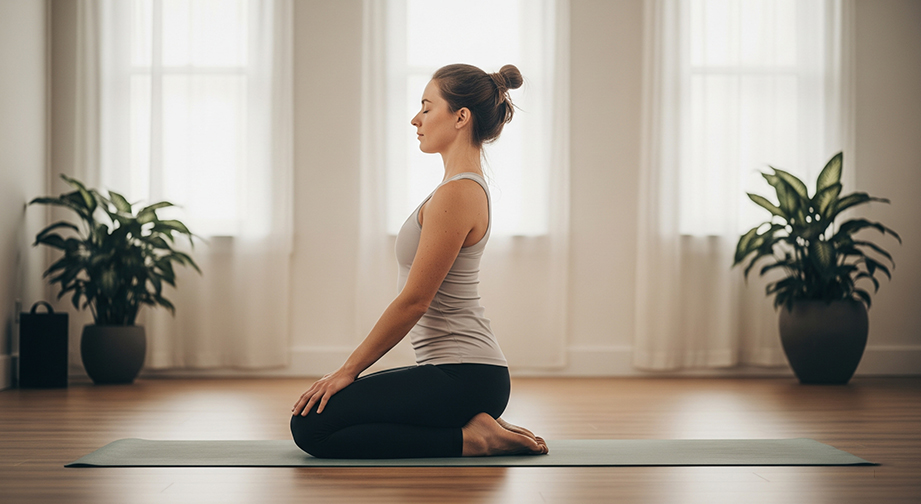Vajrasana (Thunderbolt Pose): A Complete Guide for Beginners
Introduction
Vajrasana—also known as the Thunderbolt Pose or Kneeling Pose—is a simple yet powerful yoga posture that brings calm and stability to both body and mind. The Sanskrit name 'Vajrasana' comes from vajra (meaning "thunderbolt" or "diamond") and asana (meaning "pose"). This position is all about finding strength through stillness—think of it as a grounding, calming practice you can do anytime.
Essence: Calming and grounding.
If you’ve ever felt stiff after sitting too long or struggled to relax after a meal, Vajrasana could be your new best friend!
Step-by-Step Guide to Practicing Vajrasana

- Kneel Down: Start by kneeling on your yoga mat. Bring your knees together and the tops of your feet flat on the floor, toes pointing back.
- Lower Your Hips: Gently lower your hips back onto your heels so your sit bones rest comfortably on your heels.
- Hands Placement: Place your palms on your thighs, facing down. Relax your shoulders away from your ears.
- Lengthen Your Spine: Sit upright. Imagine a thread gently pulling the crown of your head toward the ceiling. Keep your chin slightly tucked.
- Breathe: Close your eyes. Take slow, deep breaths—inhaling through your nose for a count of 4, exhaling for a count of 6.
- Inhale as you lengthen your spine.
- Exhale as you relax your shoulders and jaw.
- Hold the Pose: Remain in Vajrasana for 1–5 minutes, depending on your comfort. With practice, you can stay up to 10–15 minutes.
- Modifications for Beginners: Place a folded blanket or yoga block between your calves and thighs for comfort.
- For Advanced Practitioners: Practice with eyes closed for a deeper meditative state—or try dynamic breathing techniques.
Alignment & Safety Tips
- Key alignment: Keep knees together; heels just slightly apart, so your hips can rest comfortably.
- Lengthen the spine: Don’t slump—lift up from your pelvis through the crown of your head.
- Relax: Shoulders relaxed, no tension in the neck or jaw.
- Avoid leaning forward or back: Body should be centered over your pelvis.
- Common mistakes:
- Slouching in the back—keep your spine straight.
- Knees too far apart—knees should ideally touch or be parallel.
- Pain in ankles or knees—use props for support.
- Safety Precautions: Avoid Vajrasana if you have a knee, ankle, or recent foot injury, or if you struggle with severe arthritis.
- Pregnant practitioners: Only with modifications/specialist guidance.
Benefits of Vajrasana (Thunderbolt Pose)
Physical Benefits
- Improves digestion and can relieve bloating or gas
- Reduces tension in the lower back and knees
- Helps correct posture and relieves back pain
- Strengthens pelvic muscles and thigh muscles gently
- Suitable for those with stiff joints (with proper support)
Mental Benefits
- Calms the mind and nervous system
- Promotes stillness, patience, and focus
- Can be used for meditation and mindfulness practices
- Helps relieve anxiety and stress
Energy/Chakra Connection
- Grounds root chakra (Muladhara), enhancing feelings of safety and stability
- Facilitates pranic flow, especially after meals
Contraindications
- Recent or chronic injury to knees, ankles, or feet
- Severe arthritis (unless supported and cleared by a doctor)
- Pregnancy (unless modified and approved by a yoga therapist)
- Circulatory disorders where kneeling is not advised
Safe alternatives: Try seated cross-legged (Sukhasana) or supported Hero Pose (Virasana) with blocks if Vajrasana is not accessible.
Beginner’s Tips & Variations
- Props: Sit on a folded blanket, bolster, or yoga block between your heels if hips or knees feel strained.
- Sensitive feet: Roll a towel under your ankles for extra support.
- Gentle variation: Widen the knees slightly or don’t sit fully back until flexibility increases.
- Advanced: Add gentle spinal twists, or sit in Vajrasana for meditation pranayama (breath work).
How to Include Vajrasana in a Yoga Flow
- Works beautifully as a warm-up, transition, meditation seat, or relaxation pose after meals.
- Pairs well with: Child’s Pose (Balasana), Cat/Cow (Marjaryasana/Bitilasana), or Forward Fold (Paschimottanasana).
- Great for a calming finish to your practice or for breathwork/meditation.
Mind-Body Connection
As you sit in Vajrasana, bring your awareness to your breath and the sensations in your body. Let this pose be a reminder to ground yourself, tune into the present moment, and invite calm to both body and mind. On a spiritual level, Vajrasana is said to activate the root chakra, supporting your sense of grounding, stability, and inner peace.
Summary Box
Asana Name: Vajrasana (Thunderbolt/Kneeling Pose)
Level: Beginner
Focus Areas: Knees, ankles, thighs, spine, digestion
Duration: 1–5 minutes (up to 15 with practice)
Best Time to Practice: Morning, after meals, or anytime you need calm
Frequently Asked Questions (FAQ)
Can I practice Vajrasana right after eating?
Yes! Vajrasana is one of the few yoga poses that is safe (and even recommended) right after a meal to aid digestion.
Is Vajrasana safe for everyone?
Most people can try Vajrasana, but if you have knee, ankle, or recent foot injuries, use props or avoid this pose. Always consult your doctor if you have medical conditions.
How often should I practice Vajrasana?
Daily practice is gentle and beneficial—even just 1–2 minutes a day can help build calm and support digestion.